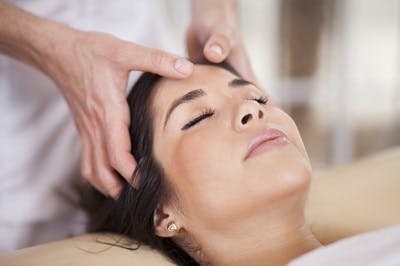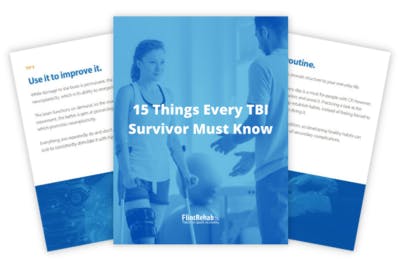No products in the cart.
No products in the cart.
No products in the cart.
No products in the cart.
Home » Neurological Recovery Blog » Traumatic Brain Injury » Craniosacral Therapy for Traumatic Brain Injury: Claims and Clinical Evidence
Last updated on March 17, 2021

Supporters of craniosacral therapy (CST) claim that it has the potential to relieve many secondary effects of traumatic brain injury. But does it work?
CST is a controversial alternative to traditional medicine with its fair share of supporters and critics. To help you determine if it’s worth trying, this article will examine arguments both for and against it.
Craniosacral therapy involves applying light pressure on the skull, neck, and spine to “release restrictions in the craniosacral system to improve the functioning of the central nervous system.” It’s a gentle, non-invasive therapy, and the pressure applied does not exceed five grams, which is roughly the weight of a nickel.
Craniosacral therapy was invented in the 1970s by John Upledger, a doctor of osteopathy. It has since been used to treat a variety of conditions, including TBI.
The craniosacral system (CSS) consists of meninges, bones, and cerebrospinal fluid that surround and protect the brain and spinal cord. It’s suggested that restricted flow of cerebrospinal can affect central nervous system functions such as transmitting motor and sensory signals or controlling the autonomic nervous system.
Ultimately, the goal of craniosacral therapy is to remove restrictions from the CSS and optimize the flow of cerebrospinal fluid.
Now that you understand how craniosacral therapy works, let’s discuss the secondary effects of TBI it may help treat.

According to Upledger, craniosacral therapy may improve the functioning of a variety of body systems. In addition to the central nervous system, CST may promote performance of the digestive, musculoskeletal, respiratory, and circulatory systems.
Specifically for individuals with TBIs, craniosacral therapy is suggested to help reduce:
But how effective is it? In the following section, we’ll explore what clinical evidence tells us about craniosacral therapy for traumatic brain injury.
As with most complementary and alternative therapies, scientific evidence supporting its effectiveness can be difficult to consistently reproduce.
While scientific studies either for or against craniosacral therapy are sparse, research conducted on a group of ex-NFL players with severe post-concussive symptoms showed some promise.
After ten two-hour CST sessions, the participants all experienced significant improvements in their sleep, memory, range-of-motion, and cognition.
However, it should be noted that the participants were also receiving other types of therapy (including visceral manipulation and neural manipulation) during the study. Therefore, the benefits cannot be solely attributed to CST.
In the following section, we’ll discuss arguments against craniosacral therapy.
Critics of craniosacral therapy have many concerns about the practice. One is the lack of positive evidence for the therapy.
The main objection to craniosacral therapy, however, is that its foundational assumption is false: a person cannot manipulate the bones of the skull enough to affect the circulation of cerebrospinal fluid.
Additionally, neuroscientists have discovered that cerebrospinal fluid is primarily regulated by respiration. Therefore, it’s more likely that the breathing techniques used during a craniosacral therapy session are responsible for the increased circulation of cerebrospinal fluid.
While craniosacral therapy may provide some benefits, they’re ultimately so subtle that they cannot be directly measured and consistently reproduced, resulting in insufficient evidence.
Because there is not yet a solid, scientific basis for the mechanics of craniosacral therapy, most doctors refrain from recommending it. Likewise, most insurances do not cover craniosacral therapy and it will need to be paid for out-of-pocket.
Still, some people claim to experience therapeutic benefits from CST. While it can’t replace traditional treatment, it may work as a complementary therapy. As long as you do not use CST to diagnose any issues you have, there is no harm in trying it. The therapy is extremely gentle, so the risk of adverse side effects is minimal.
We hope this article helped you better understand what craniosacral therapy is and how it may help individuals with traumatic brain injuries.

If you like our content, you’ll love our ebook and newsletters! Get instant access to our TBI recovery tips ebook with 20 pages of helpful advice by signing up below.
You’ll also receive our emails that share survivor stories and more useful TBI recovery tips, which you can opt out of at any time. (We know you’ll love them, too.)
We will never sell your email address, and we never spam. That we promise.


Time with a speech therapist is extremely valuable during recovery, especially if you struggle with communication, critical thinking, or memory after brain injury. Insurance typically covers speech therapy for a fixed amount of time. But once it’s over, recovery is in your hands.
That’s why a team of neuroscientists and clinicians from Boston University created the CT Speech & Cognitive Therapy app. Designed for those recovering from stroke, TBI, or living with neurological conditions, the app contains over 100,000 cognitive exercises that are all available right from your phone or tablet. That’s like having a speech therapist by your side whenever you want!
This app is the perfect fit if you want to improve your speaking, memory, or general mental sharpness. And, it’s affordable at just $29.99/month!
“For the past 6 months, my son has used the app about three times a week. The app is like a virtual therapist, it’s very easy to use, and it gives him immediate feedback.
He now understands things faster, can make decisions with less hesitation, has improved recognition of words, and his confidence is higher. I also find it easy to get in touch with customer service; they pleasantly help out. The whole experience has been great.”
— Miriam
With the CT App, you can get the guidance you need right from your phone or tablet. You can use it on your own or in between sessions with your speech therapist.
Whether you struggle with aphasia, memory loss, or critical thinking, the CT Speech & Cognitive Therapy App can help.
“The CT app has helped me gather my confidence by building on and reinforcing old forgotten skills. It helps to see my percentages increase, and work harder when they decrease. It’s very self-motivating.” -Kathryn
We are confident that this app will help improve your speech and cognitive function after brain injury. Like our recovery tools, the CT App is also covered by our 30-day money-back guarantee.

Do you know these 15 TBI recovery tips?
Get a free copy of our ebook 15 Things Every TBI Survivor Must Know. Click here to get instant access.
Grab a free rehab exercise ebook!
Sign up to receive a free PDF ebook with recovery exercises for stroke, traumatic brain injury, or spinal cord injury below: